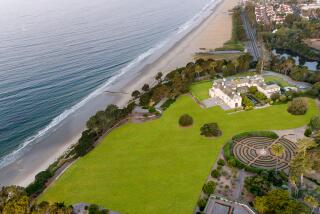Museum’s Look at the Past Is Hands-On
The Centennial Heritage Museum in Santa Ana is facing economic hardship, but you’d never know it by the hundreds of schoolchildren who traipse through its late 19th century homes each week.
The 1898 Kellogg House, the 1899 Maag House, a nature center, a small orange grove and a picnic area make up the museum complex, sandwiched on 4 acres between industrial buildings on Harvard Street.
Inside the Kellogg House, moved to the site in 1980, time seems to have stood still. On the desk once used by Hiram Clay Kellogg, who was Orange County’s first civil engineer, an Underwood typewriter seems as if it had been in use just a minute ago. His calling card rests nearby: “Kellogg Bros. Contractors for Vineyard Planning. Laying Out a Specialty. H.C. Kellogg. Deputy County Surveyor.”
Indeed, Kellogg planned most of Santa Ana, including its railroads, sewers and roads. He also had a hand in planning some nearby communities.
On a recent day, second-graders from Philip J. Reilly Elementary School in Mission Viejo giggled as they discovered how he and others in that era lived.
The cellphone generation learned, among other things, how telephones were used before the advent of rotary dials and push buttons.
Standing before an antique telephone, docent Lauren Andrews explained that party lines, which allowed neighbors to hear one another’s conversations, were the only way to communicate by phone.
“Would you want to tell your deepest secrets on this phone?” asked Andrews, who wore period clothing: a long skirt, high-necked blouse and black lace-up shoes.
The children walked from room to room, where they played with 100-year-old pick-up-sticks and heard the tin sound of the “Swanee” one-step on a Victrola. The children learned that records were like today’s compact discs and that the pump organ, which Andrews demonstrated, sufficed as entertainment long before television video games.
They made butter with antique tools in the kitchen and picked oranges off the trees. Everyone, even the boys, donned corsets that women once wore to create their hourglass figures.
“The way they used to dress was cool,” said Tiffany Andrews, 8. “I liked trying on the clothes because it was different.”
Docent Adam England revels in teaching the children about history. “We take them back in time to when their grandparents lived,” he said.
Although attractive to children, the museum has been struggling. The museum and the Discovery Science Center once shared directors and finances. In the mid-1990s, the science center moved to a new location and split from the museum. Later, the Santa Ana Unified School District, which owns the museum property, took 13 acres from the site to use for Hector Godinez Fundamental High School.
“We are supremely proud of the fact we have survived the past 10 years,” said volunteer Executive Director Cheryl Brothers. The loss of the Discovery Science Center “left us without the support system we had depended on,” she said.
Brothers said money needed to be raised for deferred maintenance, such as repairing dry rot, eradicating termites, fixing drainage problems and painting the buildings’ exteriors.
An agreement with the science center prevented the museum from doing corporate fundraising until recently, she said. With that limitation lifted, the museum is seeking new sources of funding. Officials hope to continue restoring the Maag House, named after its previous owner, John Anton Maag, which could be used for rotating exhibits and meeting space.
Supporters want to increase the museum’s $350,000 annual budget to $500,000, partly to pay for deferred maintenance. School field trips to Kellogg House, which cost $8 per child, pay for only half the cost of offering them, said Operations Manager Colleen Mensel.
She said the museum had crafted new ways for the public to use its facilities. Officials are promoting Kellogg House for community events and weddings, as a meeting place for youth organizations and for birthday parties.
In addition, officials will offer a three-week summer camp program this year. Children will be able to pan for gold, build adobe bricks, take a Tom Sawyer adventure and make silent movies.
Public tours of the Kellogg House are offered Wednesday through Friday from 1 to 5 p.m. and on Sundays from 10 a.m. to 3 p.m. The cost is $5 for adults, and $4 for seniors and children from 3 to 12.
The tours help many children -- like the recent visitors from Reilly Elementary -- appreciate the comforts of 21st century living. Christian Lee, 7, is happy he doesn’t have to wear a corset, with all of its attendant hooks and straps.
“Now we have electricity, we can do more things,” he said, “and we don’t have to worry about anyone wearing that thing that goes across your chest.”


